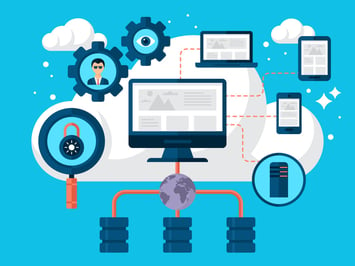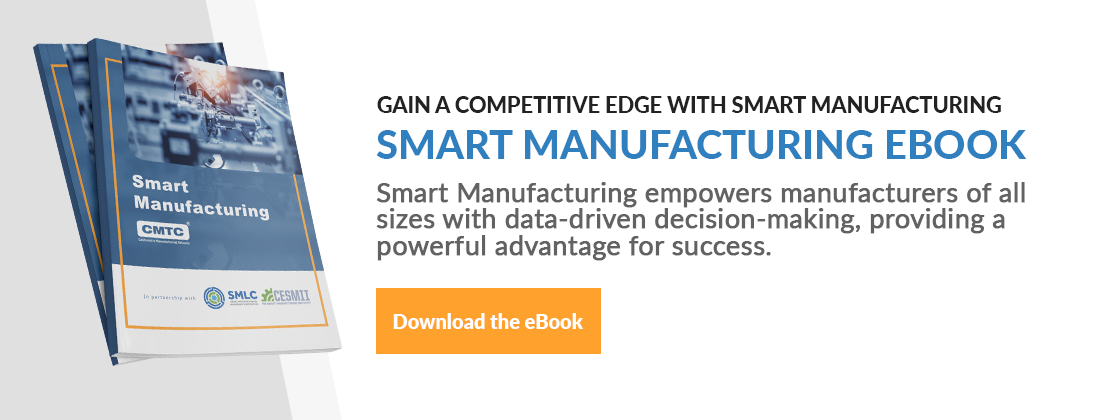October 5, 2015 | Smart Manufacturing
Smart Manufacturing Infrastructure, Data & Security (Part 5 of 6)
This post is the fifth installment of six regarding the concept of Smart Manufacturing (SM). This series aims to inform manufacturers of SM’s components, how it affects business productivity, economics and plans, its importance in the value chain, how it changes the workforce and the future of manufacturing overall. This series is written in conjunction with the Smart Manufacturing Leadership Coalition (SMLC).
If you missed the first few blogs of this series, you can click on their links here: Part 1A, Part 1B, Part 2, Part 3 and Part 4.
What will be the necessary changes that manufacturers must undergo to reap the full benefits of Smart Manufacturing?
In this post, we’ll address infrastructure changes, sensor technology, cloud computing and how all of these might affect the security concerns of manufacturers. We’ll also delve into the benefits of having access to real-time data for prompt decision-making.
It’s understood that making a company-wide change in business, regardless of industry, can be both daunting and expensive. However, one of the major benefits of the Smart Manufacturing Platform and Marketplace is its ability to minimize these concerns while making the overall goal of improved manufacturing operations affordable and attainable.
Infrastructure Changes: The What, Where & Why
How much is this going to cost me? What new equipment will I have to purchase? How long will it take to install, and what’s the cost? What will it take (time and cost) to shake out all of the necessary kinks to have an effective, secure operating environment with a trained workforce? Of course, those are the main concerns of any manufacturer.
A common misconception about Smart Manufacturing (SM) is that it will require organizations to drastically transform their current operations and invest in advanced technology that will be too complex to adjust to. While some change is necessary, of course, SM greatly simplifies this transition by building to the capabilities that manufacturers have currently.
One of the key concepts of Smart Manufacturing is recognizing the value of data as a key asset to be developed and managed. Put another way, for a system that analyzes data, the key asset is not the analytics system itself but the data itself. It’s the data used to build and validate the analysis and the data that are generated. Such an emphasis on data causes us to think differently about where to focus resources.
For any operational objective, there needs to be a source of relevant data. The sources of data can be as basic as a fax machine, tablet or smartphone -- or as sophisticated as a wide area sensor network. The point is data are valuable in the context of the operational objective, not the sophistication of the sensors. There are many highly beneficial applications that can draw upon data.
Put simply, as long as it’s possible to get data to the SM network, the factory can begin its SM journey. Infrastructure changes needed to accommodate the applications that use and act on the data happen within the SM platform — giving manufacturers the convenience of making less drastic changes within their facilities. (See Part 1B explaining the SM Platform and its capabilities.)
Smart Manufacturing will lead to significant changes in business opportunities and operations over time. Jim Davis, Vice Provost of Information Technology at UCLA, stresses the importance of starting small and working Smart Manufacturing as a progression.

The SM Platform is designed for progression so that companies start benefiting at any level of readiness, with the ability to focus on smaller challenges and then move to larger challenges as they grow in experience and sophistication. Progression becomes viable when the infrastructure costs are drastically lowered and removed from the equation.
Data: The Glue between Operations & Results
End-to-end sensor-to-action software systems that have been cost-prohibitive will become more affordable. B2B applications will have a trusted and secure platform that supports IP policies encouraging collaboration with respect to data, models, and analytics, as well as ensuring data owner agreements, policies, regulatory requirements, etc.
In a fully developed smart factory and/or supply chain, employees will be able to access pay-per-use applications from an SM Platform Marketplace, assemble data management, analytics, models, dashboards and interface applications into a full range of enterprise systems, including real-time systems for optimization. Data are drawn from sensors and/or manually input data from operations. Manufacturing workers in the loop are readily accommodated, including validation and decision-making. The employee can focus on function and outcome and not on infrastructure technology and maintenance.
When there is an ability to begin using data more robustly, manufacturers can begin to see untapped opportunities— and in real-time. For example, enterprise analytics across the plant floor operations give managers the ability to pinpoint areas of opportunity not readily seen otherwise.
“If you’re able to “see” the product while it’s in production and “see” the overall production process, it opens quite a few doors to be responsive to product and manufacturing demands as well as more dynamically predict and adjust to improve productivity and the quality of the product,” says Davis.
There is quite a bit of untapped opportunity by now, considering the enterprise and not just vertically optimized operations. Initial benefits are invariable with performance. This includes less downtime, fewer defects, unnecessary back-and-forth adjustments, higher productivity with quicker, more effective ways to manage the manufacturing operations and the quality of the product.
Many possibilities that have already been considered but are cost prohibitive now become doable. Progression enables manufacturers to grow into using big data for new operational insights.
Using Sensors and Data Today
In terms of SM, the implementation of sensor and data collection methodologies should always have an objective. “It’s far better to start with a fairly simple problem and understand the intended outcome before applying more data and additional sensors to help navigate the solution,” explains Davis.
For example, if we refer back to the idea of progression, starting with a less ambitious objective often leads to a more contained data and sensor set. This is advised so a facility can master its data capabilities and, most importantly, get to really know the data and learn from it. With this kind of staged approach, the manufacturer can determine set objectives, ensure growth, reduce risk and conserve capital. It is all about thinking about how data can move a business and/or operation to achieve efficiencies or increase revenue.
The Cloud, IT & Interoperability
In Smart Manufacturing’s IT infrastructure (SM Platform), companies will be able to access applications and resources from the cloud that can be directly used to analyze and manipulate data to the benefit of their manufacturing processes.
The open infrastructure scales to lower cost and interoperate securely with commercial applications and infrastructure providers. Most importantly, the SM Platform makes it possible to substantively reverse the mindset about data, applications and IT infrastructure.

Today’s prevailing mindset places value and investment on software application and IT Infrastructure. In Smart Manufacturing, value is placed on the data and the outcomes. The applications and infrastructure are the means to an end. When IT vendor products, data sources, or systems need to be integrated so that data can be accessed, merged, and applied, it can be done more easily.
Rather than being restricted to using less-than-ideal software or constricted with moving to new software, SM makes it possible for small, medium and large manufacturers to more easily change. By reducing the emphasis on infrastructure, companies can reach untapped potential with more resources and innovation available at their fingertips through the data.
Piloting new technologies that draw further information from the data with low risk should be easier. Resources include individual software applications, libraries, deployment infrastructure for setting up simple to complex real-time data systems and non-proprietary shared data and information about applications (not operations) and trusted and secure data interoperability for B2B collaboration opportunities with other companies.
The SM Platform and Marketplace allow for easy collaboration through managing the integration of multiple cloud services, security, and intellectual property requirements on behalf of the manufacturer and solution providers. In addition, IT integrators will reap the benefits of having to deal with fewer sources, servers, drivers and database structures.
“What we’re doing with the Platform is providing a set of services in an integrated cloud format that significantly lowers the infrastructure set up and integration that is as much as 70% of the cost of a one-off system.”
As mentioned, the SM Platform provides a consistent and scalable infrastructure for progressively extending a system – when one wants to extend with more data and new analytics or when infrastructure technologies grow out of date, etc., there is no longer a need to tear out and build new infrastructure. Smart Manufacturing offers solutions that can evolve with technology.
Security & Intellectual Property
Manufacturers are appropriately cautious about the security of valuable data, information and IP, especially when it comes to cloud-based technology. But, a major security advantage of SM infrastructure is that security risks are being addressed at every level and across all interfaces, horizontally and vertically, while the system is being built.
“Security and interoperability are fundamental to the SM Platform foundation. But no system is 100% secure. Security risk detection and mitigation are as important as prevention,” states Davis. “The platform infrastructure actually provides additional security prevention for the manufacturer.

It provides ways to detect, compartmentalize and mitigate attacks. When a manufacturer wants to work with multiple vendors or work with protected data sharing, security requirements are enforced and do not need to be “reinvented” for every interchange.”
Not only does the platform offer the possibility of greater security than many individual plants and with many B2B treatments of security, it also makes it possible for users to access and view data in ways that are not possible in enterprise operations and supply chains today (and which isn’t able to be done through individual vendors).
“You can see the data moving end-to-end, and if you see a pattern different than expected, you have new security information that you don’t have with the way it’s being done today.” The focus on data and its management rather than applications makes it possible for intellectual property, regulations and policies to be managed in far better ways that remain owner-controlled
Staying Online
“A critical element of the platform infrastructure is its robust, large-scale cloud technologies,” explains Davis. Referencing companies that are practically resistant to IT shutdowns, like big online shopping sites, the SM infrastructure’s redundancy measures will prevent servers from unexpectedly bottlenecking or shutting down.
Modern cloud technologies change the hardware perspective from one of ‘server nurture’ at individual sites to one of rapid server replacement at large-scale sites. This leads to a more robust and secure IT environment. “We’re bringing the cloud technologies that have been well-accepted in other industry sectors to manufacturing.”
Contributor to this blog post included an interview with Jim Davis, the Vice Provost of Information Technology at UCLA and Bob Graybill, President and CEO of Nimbis Services.

